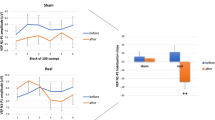Abstract
Persistent aura without infarction (PAWI) is one of the complications of migraine. In comparison to classic migraine aura, pathological visual phenomena are present constantly, at least for 1 week, but often for more. An efficient treatment for PAWI is currently unknown. Repetitive transcranial magnetic stimulation (rTMS) is a progressive, non-invasive therapeutic method using a magnetic field transmitted through a special coil to activate the neural tracts in the brain. The efficacy of rTMS has been proven in treating several neurological disorders. The aim of this review article is to suggest a proper rTMS protocol for treating PAWI in the pursuance of studies to date.


Similar content being viewed by others
Abbreviations
- PAWI:
-
Persistent aura without infarction
- rTMS:
-
Repetitive transcranial magnetic stimulation
- HF:
-
High frequency
- LF:
-
Low frequency
References
Battelli, L., Black, K. R., & Wray, S. H. (2002). Transcranial magnetic stimulation of visual area V5 in migraine. Neurology, 58(7), 1066–1069.
Boroojerdi, B., Prager, A., Muellbacher, W., & Cohen, L. G. (2000). Reduction of human visual cortex excitability using 1-Hz transcranial magnetic stimulation. Neurology, 54(7), 1529–1531.
Brighina, F., Piazza, A., Daniele, O., & Fierro, B. (2002). Modulation of visual cortical excitability in migraine with aura: effects of 1 Hz repetitive transcranial magnetic stimulation. Experimental Brain Research, 145(2), 177–181.
Brighina F, Palermo A, Daniele O, Aloisio A, Fierro B. High-frequency transcranial magnetic stimulation on motor cortex of patients affected by migraine with aura: a way to restore normal cortical excitability? Cephalalgia [Internet]. 2009 May [cited 2016 Jul 17]; Available from: http://cep.sagepub.com/cgi/doi/10.1111/j.1468-2982.2009.01870.x.
Chen, W.-T., Lin, Y.-Y., Fuh, J.-L., Hämäläinen, M. S., Ko, Y.-C., & Wang, S.-J. (2011). Sustained visual cortex hyperexcitability in migraine with persistent visual aura. Brain, 134(8), 2387–2395.
Fierro, B., Ricci, R., Piazza, A., Scalia, S., Giglia, G., Vitello, G., et al. (2003). 1 Hz rTMS enhances extrastriate cortex activity in migraine evidence of a reduced inhibition? Neurology, 61(10), 1446–1448.
Fumal, A., Coppola, G., Bohotin, V., Gérardy, P.-Y., Seidel, L., Donneau, A.-F., et al. (2006). Induction of long-lasting changes of visual cortex excitability by five daily sessions of repetitive transcranial magnetic stimulation (rTMS) in healthy volunteers and migraine patients. Cephalalgia, 26(2), 143–149.
Galeotti, N., Ghelardini, C., Zoppi, M., Del Bene, E., Raimondi, L., Beneforti, E., et al. (2001). Hypofunctionality of Gi proteins as aetiopathogenic mechanism for migraine and cluster headache. Cephalalgia Int J Headache, 21(1), 38–45.
Lefaucheur, J.-P., André-Obadia, N., Antal, A., Ayache, S. S., Baeken, C., Benninger, D. H., et al. (2014). Evidence-based guidelines on the therapeutic use of repetitive transcranial magnetic stimulation (rTMS). Clinical Neurophysiology, 125(11), 2150–2206.
Mastík MudJ. Perzistující migrenózní aura bez infarktu. [cited 2016 Jul 17]; Available from: http://www.neurologiepropraxi.cz/savepdfs/neu/2012/01/04.pdf.
Minks E. Parkinsonova nemoc: Ovlivnění motoriky nízkofrekvenční repetitivní transkraniální magnetickou stimulací (rTMS) cerebella a zpracování nevědomé senzorické informace při intracerebrálním snímání mismatch negativity (MMN). Neurofyziologická studie [Internet] [Doctoral thesis]. Masarykova univerzita, Lékařská fakulta; 2014 [cited 2017 Jul 14]. Available from: https://is.muni.cz/th/19762/lf_d/.
Minks, E., Mareček, R., Pavlík, T., Ovesná, P., & Bareš, M. (2011). Is the cerebellum a potential target for stimulation in Parkinson’s disease? Results of 1-Hz rTMS on upper limb motor tasks. Cerebellum London England, 10(4), 804–811.
Mulleners, W. M., Chronicle, E. P., Palmer, J. E., Koehler, P. J., & Vredeveld, J.-W. (2001a). Visual cortex excitability in migraine with and without aura. Headache J Head Face Pain, 41(6), 565–572.
Mulleners, W. M., Chronicle, E. P., Palmer, J. E., Koehler, P. J., & Vredeveld, J. W. (2001b). Suppression of perception in migraine evidence for reduced inhibition in the visual cortex. Neurology, 56(2), 178–183.
Palmer, J. E., Chronicle, E. P., Rolan, P., & Mulleners, W. M. (2000 Jul). Cortical hyperexcitability is cortical under-inhibition: evidence from a novel functional test of migraine patients. Cephalalgia International Journal of Headache, 20(6), 525–532.
Schankin, C. J., & Goadsby, P. J. (2015). Visual snow—persistent positive visual phenomenon distinct from migraine aura. Current Pain and Headache Reports, 19(6), 23.
Siebner, H. R., & Rothwell, J. (2003 Jan). Transcranial magnetic stimulation: new insights into representational cortical plasticity. Experimental Brain Research, 148(1), 1–16.
Wassermann, E. M. (1998). Risk and safety of repetitive transcranial magnetic stimulation: report and suggested guidelines from the international workshop on the safety of repetitive transcranial magnetic stimulation, June 5-7, 1996. Electroencephalography and Clinical Neurophysiology, 108, 1):1–1)16.
Author information
Authors and Affiliations
Corresponding author
Ethics declarations
Conflict of Interest
The authors declare that they have no conflict of interests.
Rights and permissions
About this article
Cite this article
Lukáčová, V., Mastík, J. & Minks, E. Could Repetitive Transcranial Magnetic Stimulation (rTMS) Help Patients with Visual Snow?. Act Nerv Super 60, 27–31 (2018). https://doi.org/10.1007/s41470-018-0014-7
Received:
Accepted:
Published:
Issue Date:
DOI: https://doi.org/10.1007/s41470-018-0014-7



